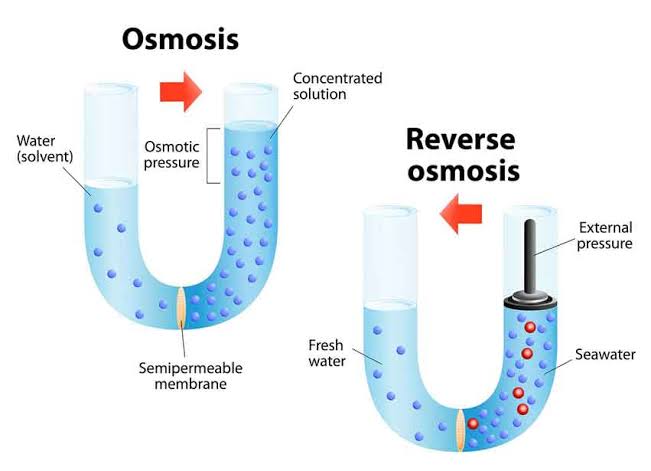Everything You Need to Understand About Reverse Osmosis

Reverse osmosis has become popular in recent years because it is an environmentally friendly way to clean water. This membrane filters out impurities and other particles contained in the liquid.
Reverse osmosis is perfect for homes with limited clean water.
This post will provide all the information you need about reverse osmosis and whether reverse osmosis suits your water filtration needs.
What is Reverse Osmosis?
Reverse osmosis is a water purification process that involves passing water through a special plastic membrane sheet to remove various compounds such as salts, organic compounds, microorganisms, viruses, and pharmaceuticals.
The membrane sheets are wound into cylinder-shaped elements, and multiple elements are housed inside long pressure vessels. Water enters the vessel and flows over the thin membrane surface, allowing water to pass through while preventing other compounds from passing through.
As a result, contaminants larger than water molecules, including chemical contaminants and microorganisms, are removed. The process produces two streams of water: pure, clean water called permeate, which flows across the membrane sheets and is collected, and highly concentrated water called concentrate, which contains salts and other substances and can be further processed. Reverse osmosis can purify about 82 percent of the source water.
Stages of a Reverse Osmosis System:
In reverse osmosis (RO), several stages combine to purify water by removing pollutants and impurities. Now, let’s explore the specific phases involved in a reverse osmosis system:Pre-filtration:This first stage involves passing the water through pre-filters to remove large particles, sediment, chlorine, and other common contaminants. In addition, pre-filtration helps protect the delicate semi-permeable membrane in the subsequent stages from potential damage.
Pressure Pump:
Within a reverse osmosis system, an indispensable component known as the pressure pump assumes the critical role of applying substantial pressure to the water. This firm pressure triumphs over the innate osmotic pressure, propelling the water molecules through the semi-permeable membrane. By employing the pressure pump, the system guarantees a smooth and efficient water flow, significantly enhancing the overall effectiveness of the reverse osmosis process.
Reverse Osmosis Membrane:
In the third stage of the reverse osmosis process, the water embarks on a transformative journey through the semi-permeable membrane. This remarkable membrane acts as a vigilant guardian, armed with minuscule pores that selectively permit the passage of water molecules while vehemently obstructing larger molecules, ions, and contaminants. As the water is propelled under pressure through this membrane, a separation process unfolds, leaving behind a trail of impurities, including dissolved salts, heavy metals, bacteria, viruses, and other menacing substances. With each passing moment, the water sheds its burdens, emerging on the other side, purified, refreshed, and liberated from the shackles of contamination.
Post-filtration:
The water enters the post-filtration stage after passing through the reverse osmosis membrane. This stage involves another set of filters, including activated carbon filters, which remove any remaining tastes, odors, or residual contaminants. The post-filtration process ensures the water is thoroughly purified and ready for consumption.
Storage Tank:
Once undergone through reverse osmosis and post-filtration, the water is collected in a storage tank. This tank is typically made of food-grade materials and is pressurized to maintain a steady flow of purified water. The storage tank ensures a constant supply of treated water, even when no immediate demand exists.
Final Polishing:
In some reverse osmosis systems, an additional stage called final polishing is employed to enhance the water quality further. This stage involves using a carbon filter or a remineralization filter. The carbon filter removes any remaining impurities, tastes, or smells, while the remineralization filter adds necessary minerals to the water, improving its flavor and health benefits.
Faucet Dispenser:
The final stage of a reverse osmosis system delivers the purified water for consumption. The faucet is typically installed on the sink or countertop and allows users to access the clean and refreshing water produced by the system.
Factors to Consider While Choosing a Reverse Osmosis (RO) System:
Several important factors must be considered when selecting your home’s reverse osmosis (RO) system.
Here are some key considerations:
Source Water: Understanding the type and quality of your source water is crucial. The level of impurities and contaminants can vary whether you receive water from a municipal supply or private well. Understanding your source water will help determine the required level of filtration accuracy.
Water Flow Rate:
Efficiency is an essential aspect of any RO system. Consider the water flow rate, which indicates how quickly the system can produce purified water. Some systems may have slower flow rates, leading to longer waiting times for a glass of water. Look for systems that offer reasonable flow rates to meet your household’s needs.
Daily Water Capacity:
RO systems have a finite capacity regarding the number of gallons they can filter daily. Therefore, depending on the number of individuals in your home and your daily water usage, you should choose a system with a suitable capacity. Fewer capacity systems may suffice for a few individuals, while larger ones are better suited for households with higher water demands.
Waste Water Ratio:
Wastewater is a common concern regarding RO systems. Some systems may produce more wastewater than filtered water, which can be inefficient and wasteful. Look for systems with a wastewater-to-purified water ratio of 1:1, considered an ideal benchmark for efficient water usage.
Installation:
Consider the installation process and whether it requires professional plumbing services or can be done as a DIY project. Opt for systems that offer easy installation instructions and do not involve complicated procedures. This ensures you can set up the system without additional costs or technical difficulties.
Available Space:
Evaluate the space under your sink where the RO system will be installed. Traditional RO systems come with a storage tank, which occupies additional space. Newer tankless designs have filtered water quickly and eliminated the need for a storage tank. These tankless systems save space and reduce the risk of secondary pollution.
Considering these factors, you can make an informed decision when choosing a reverse osmosis system that suits your specific requirements. Remember to assess the source water, flow rate, daily capacity, waste water ratio, installation process, and available space to select the best RO system for your home.
Benefits of Drinking Reverse Osmosis (RO) Water
Reverse osmosis (RO) water, produced through a popular water filtration method, offers several benefits for those seeking cleaner and purer drinking water. Here are the key advantages of drinking RO water:
Removal of Contaminants:
RO systems excel at eliminating contaminants from drinking water, surpassing other filtration methods. These systems effectively remove lead, chlorine, sodium, fluoride, pharmaceuticals, arsenic, and numerous other harmful substances. As a result, investing in an RO system can significantly enhance the quality and safety of the water you consume.
Promotes Hydration:
Drinking adequate water is crucial for maintaining proper hydration levels. RO water can be particularly beneficial in this regard, as its clean and crisp taste encourages increased consumption, making it easier to stay adequately hydrated throughout the day.
Optimal Mineral Balance:
While RO water removes impurities, it retains essential minerals such as calcium, magnesium, and potassium, vital for various bodily functions. This ensures that you receive the necessary minerals without the accompanying contaminants often found in tap water.
Customization and Safety Assurance:
There are RO systems available, such as the All-American Reverse Osmosis System with Libation Hydration Technology, that remove contaminants and add minerals back into the water. These systems ensure safety, hydration, and optimal pH levels while lowering ARP (oxidation-reduction potential). In addition, customizable options allow you to tailor the filtration process to your specific needs.
Digestive Health:
By eliminating harmful microorganisms and pollutants, RO water reduces the risk of waterborne diseases and gastrointestinal issues. It can be especially beneficial for individuals with sensitive stomachs, promoting better digestion and overall gut health.
Weight Management:
Choosing RO water over sugary drinks or calorie-laden beverages can aid in weight management. It is a zero-calorie option that keeps you hydrated without contributing to unnecessary calorie intake, supporting your weight loss or maintenance goals.
Skin and Hair Health:
The purity of RO water can positively impact your skin and hair. By avoiding the chemicals and contaminants found in tap water, you can decrease the risk of skin irritation, dryness, and hair damage. In addition, hydrated skin is more likely to maintain its natural elasticity, leading to a healthier complexion.
Environmentally Friendly:
Opting for RO water can have positive environmental implications. By reducing the consumption of bottled water, you contribute to reducing plastic waste and the carbon footprint associated with its production and transportation. A report published by Food & Water Watch states that approximately half of all bottled water comes from the tap.
Final Verdict:
In conclusion, drinking RO water offers numerous benefits, including effective contaminant removal, improved taste, convenience, and enhanced health and safety. While removing minerals is a concern, remineralization filters can be added to address this issue. Investing in a reliable RO system ensures you and your family can access refreshing, cleaner water for drinking, cooking, and washing food.To learn more about RO systems and other water purification solutions, consider booking an in-home consultation with a trusted Aqua Hygiene Water Purification Advisor who can assess your water quality and recommend the best solution.




